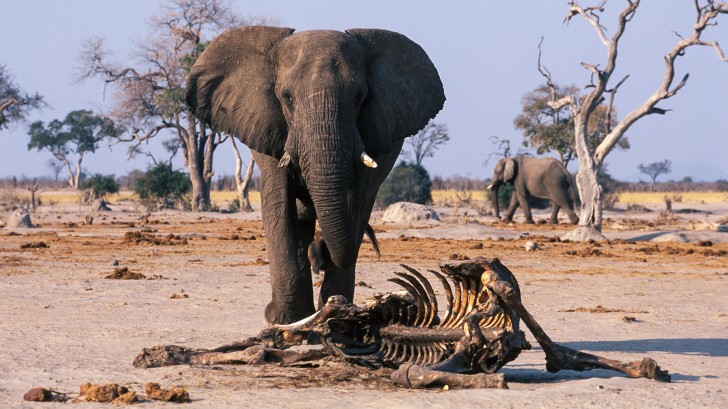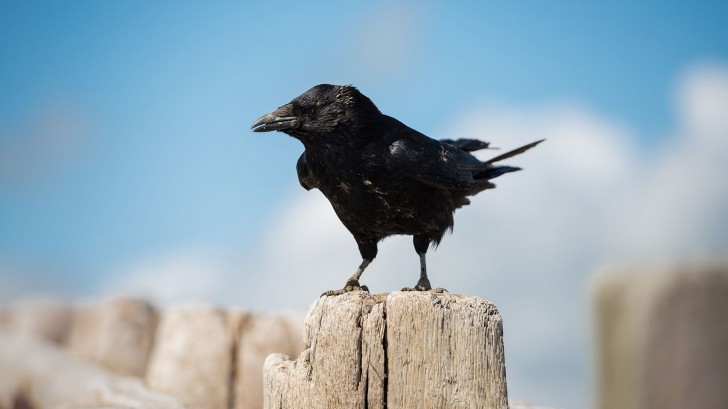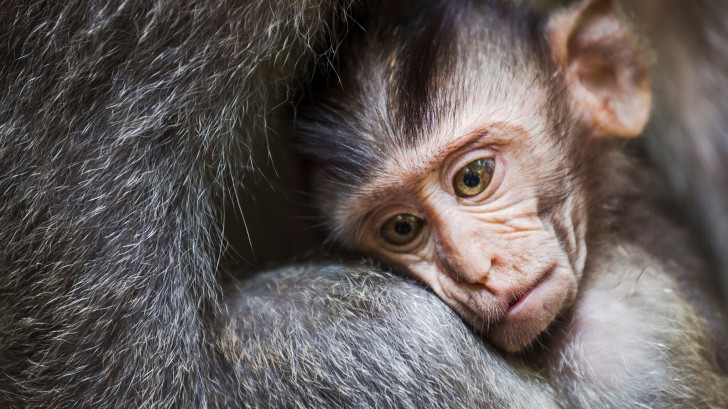Whenever animals are seen grieving the dead, we sit up and take notice. In August 2018, an orca calf died off the coast of Vancouver Island, and its mother, Tahelqua, kept its corpse with her for 17 days straight. The images made news around the world. Two years ago, at the Chimfunshi Wildlife Orphange Trust in Zambia, a female chimp named Noel attempted to clean the teeth of her dead adopted son Thomas, dubbed a “mortuary ritual” by many. Elephants are famed for visiting the remains of dead family members, stroking their bones or at times rocking back and forth in what resembles a “vigil”.
Can you die from a broken heart?
Most dramatic, in 1972 Jane Goodall witnessed a young male chimp named Flint die just a month after the death of his mother Flo – the male was so despondent following her death that he stopped eating or socializing to the point that he simply didn’t survive.
Whether or not it is possible to “die of a broken” heart, one thing is without question:
“We humans don’t own love or grief – these emotions are widespread in other animals,” says Dr Barbara J King, Emerita Professor of Anthropology at the College of William and Mary, and author of How Animals Grieve.

Darwin himself thought other animals capable of emotions such as happiness and misery, and stories of elephants mourning the dead were recorded by Pliny the Elder (23-79 AD). Yet for much of the past two centuries scientists and philosophers were extremely hesitant to describe the behaviour of any animal towards one of their dead as “grieving”, for fear of anthropomorphizing – to attribute human traits, emotions, or intentions to animals.
Over the course of her research, Dr King began to feel “that we were straight-jacketed intellectually by our fears of anthropomorphism”, so she created a set of criteria:
“If a surviving animal who had a close relationship to the newly deceased becomes socially withdrawn, failing to eat and sleep and travel in routine ways, and shows species-specific evidence of emotion – then we can see widespread evidence of an emotional response to death in animals.”
The increase in scientific evidence for grief and mourning in other species has grown so much over the past decade, the journal Philosophical Transactions of the Royal B devoted an entire issue to responses to death in both animals and humans, with the proposal to define an entire new field of study: “evolutionary thanatology”.
The ultimate goal: not simply cataloguing the range of behaviours across the animal kingdom and human cultures, but “developing a more explicit evolutionary consideration of all aspect of studies of death and dying”.
After all, if it is said “nothing in biology makes sense except in the light of evolution” then the question begs to be asked: Why should grief exist at all?
When mourning, both animals and humans behave in a variety of ways that are simply not useful to survival: withdrawing into solitude, retreating from socialising, sleeping less, eating less, foraging less, mating less, and if spending time tending to a corpse, exposing oneself to pathogens and making oneself vulnerable to predators. Taken to the next level in human cultures, with the amount of land we devote to cemeteries, the time and money we devote to funerals, and the profound pain we experience with loss, grief is even more draining – and puzzling.
What can be gained from grieving?
Certain experiences in life may be painful, but that doesn’t necessarily make them maladaptive. When we experience physical pain from a cut or a burn, that pain is an evolved response signaling to us to remove ourselves from the source of pain. Pain is useful. People born with a congenital insensitivity to pain tend to die young, accruing incessant injuries and infections. Pain is useful. But what can be gained from grieving – from retreating from the world, neglecting sleeping and eating?
In this light, understanding when, why, and how animals respond to the dead doesn’t just teach us about animal sentience, or our own evolution – it helps us understand the phenomenon of grief itself.
Because mourning is not limited to big-brained cetaceans (whales and dolphins) or primates – scientists have documented some form of “death response” in seals, manatees, dingoes, horses, dogs, housecats, and more. Striking examples include 27 adult giraffes holding a vigil for one dead baby giraffe, elephants from five different families visiting the bones of one of the dead, a group of 15 dolphins slowing their speed to escort a mother dolphin carrying her dead calf, and a strange case of two ducks rescued from a foie gras farm who formed a friendship at their sanctuary home. When one duck died, the other lay with its head on the others neck for hours.
Though charismatic mammals make headlines, responses to death can also be seen in non-mammals – such as birds, like the foie gras ducks, and wild scrub jays observed in the field.

“We wanted to move beyond anecdotes, and do an experimental study to try and drive at the adaptive value of showing an interest in dead conspecifics,” says Dr Kaeli Swift, who tested how crows would respond to dead crows, pigeons and squirrels left in their environment, publishing her results in that same issue of Philosophical Transactions of the Royal Society B. Crows were more likely to alarm call and recruit other birds in response to dead crows than pigeons or squirrels or stuffed crows mounted in a life-like pose – consistent with the idea that crows exhibit a “danger response” to dead crows.
Do humans and animals grieve in the same way?
“There is value in paying attention to your dead to teach you about ways you might die yourself – so you avoid these things,” explains Dr Swift. “There is value in understanding how this behaviour originated in order to understand our own evolution, how this behaviour went from its original state to the enormous suite it manifests in our own species.”
From this viewpoint, understanding the reasons for mourning in animals will help us understand mourning in ourselves. Our responses to death share much in common with animals. For one, like humans, animals will vary in the degree they respond to death – both individually and as species. In general, the more social the species, the more likely they will behave in a manner that could be described as grieving. And the closer two individuals, the more likely one will grieve.
Dolphins and whales for example are both highly intelligent and highly social, so it should come as no surprise that they will attend to a dead member of the pod – most frequently, a mother to a dead calf. This can involve not just dragging or carrying a dead corpse, as in the case of Tahelqua the orca, but also more spontaneous and active behaviours, such as lifting and sinking a corpse up to the surface (as if to help it breathe), and hauling, spinning, and diving with it.
Dr Joan Gonzalvo of the Ionian Project, funded by the Tethys Research Institute, has seen bottlenose dolphins attending to a dead calf on three occasions – twice, with a mother carrying her calf for several days, and once an entire pod struggling to keep a dying baby afloat, then remaining in the area for a time after it died and sank.
“Grieving is a question of coming to terms with the idea of loss,” he says. “So my hypothesis is that when the mothers carried their calves for several days, it was because the calves were newborn, so the death was unexpected and sudden. The mothers needed more time to grieve. But when the pod had to care for an animal that had been struggling for some time already, in some ways it was a relief when it died, so they could move away that day rather than carrying the body for a week.”
As strange as it might seem, carrying the dead body of an infant is extremely common among primates. Many primate species have been observed to carry dead infants for weeks or even months – in extreme instances, mothers have carried their babies until they were completely mummified by the heat, or even just a skeleton or spine remained.

But this is just one of the few ways primates might respond to death: they may exhibit physical interactions with a corpse such as grooming, teeth cleaning and gentle touching, or even rougher behaviours such as hair-pulling, attempted mounting and even cannibalism.
“Death is one of the most severe social events that can happen in a social species.”
“I have witnessed immensely gentle and careful caretaking, but males can be aggressive in other instances – they are still themselves,” says Dr King, who has observed chimps and bonobos in the wild in several responses to death. “Like with people, it’s a mix depending on the personality, and it tends to break down along friendship lines.”
It is the social dimensions in chimps that interest Dr Edwin van Leeuwen of the Max Planck Institute for Psycholinguistics. When he documented Noel cleaning the teeth of her adopted son Thomas – a highly unusual behaviour not seen before – he felt the motivations could be explains through social dynamics.
“I think she was expressing her social bond by doing something with his body,” he says. “Death is one of the most severe social events that can happen in a social species. When a more mature individual dies for example, there needs to be some reforming of social bonds. Or there may be a response by an entire group to a mother that has lost her infant, as a form of social cohesion. In mammalian species – like ourselves – where sociality is of high importance for survival, you see a strong emotional capacity for responding to death.”
For Dr Dora Biro of the University of Oxford, who has observed chimps responding to the dead twice, the implications run even deeper than that.
“From a developmental point of view, children take quite a long time to acquire a fully complete concept of death. It’s not something that comes naturally to us – it is something we acquire through experiences,” she says.
There are essentially four components to death that psychologists have identified: Irreversibility, non-functionality (the dead do not respond to anything), causality (the biological basis of death), and universality: all living things will die, including yourself.
“When, and in what order did we acquire these components?” she asks. “To understand the extent to which non-humans possess any of these components can tell us a great deal about the evolutionary origins of our own cognition.”
If grief is something we see in highly social animals, and most often seen in individuals with close social bonds, this ultimately tells us a great deal about how mourning is an evolved response to “coming to terms with the idea of loss” as Dr Gonzalvo puts it. Intelligent animals and humans need time to process it. Or, in layman’s terms: grief is the price we pay for love. Little wonder archaeological sites show signs we painted the dead with ochre over 100,000 years ago, and cultures worldwide have developed an astounding array of complex rituals, from funerary rites to cemeteries, decorated coffins to pyramids and even the strange rite of the Torajans who will live with the mummified corpse of a family member for weeks.
There is one further reason we should study grief in other animals, says Dr King.
“This doesn’t just raise the issue of animal welfare – it also points to animal rights,” she says. “If we understand the profound depths of emotions animals can feel, this should make us question the existence of zoos and slaughterhouses around the world, and rethink those systems. Because at present there is a tremendous and soulless understanding that the grief we ourselves feel is shared by all kinds of animals worldwide.”